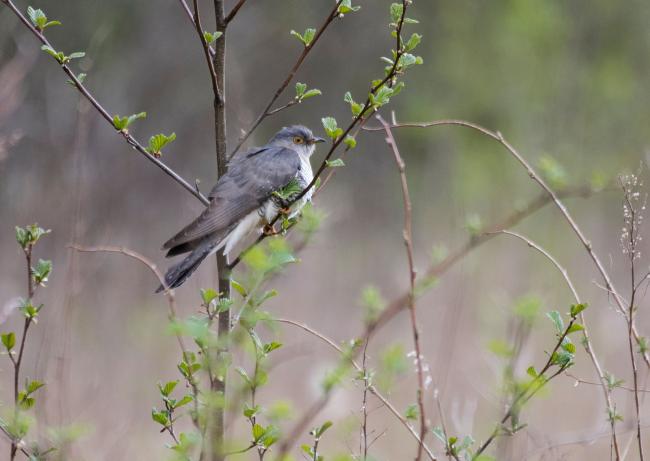Cuckoo
Cuckoo

https://elurikkus.ee/generic-hub/occurrences/11288368-69dd-4e0d-b766-3652afe53cc0
In Estonian folklore, the cuckoo is the most popular and versatile bird. Because of the male bird’s sound cuckoo-cuckoo it is also known as a ‘cuckoo-bird’ or ‘wild cock’. In folk religion a cuckoo is known as an omen bird whose sound predicts the years left to live, a death, luck, marriage, weather and the harvest. The cuckoo is special because it doesn’t build its own nest. It lays its eggs in the nests of smaller birds and leaves them to be reared by them. The cuckoo’s ‘stepparents’ are called 'cuckoo’s farmhands' or 'wives'. The cuckoo’s song provides material for puns in Estonian, because his voice is rendered as 'kuku', which matches the word 'fall!' in Estonian (kukkuma ‘to fall’). Therefore an Estonian cuckoo is literally singing: “fall, fall, fall!” Although Estonian contains many onomatopoeic words, the verb kukkuma 'to fall' has not developed from the cuckoo’s sound, but perhaps from the actual noise of falling.
Mathilda Matjus, Taive Särg (Hiiemäe 2013). Translation: Maarja Villandi-Reiljan.
A man was made a widower and brought a second wife into his house. Yet, she was a very cruel and merciless person, and couldn’t stand the daughter the man’s first wife left behind one bit. She also had her own daughter, whom she coddled at her breast, but the woman hated and harassed her stepdaughter. The woman always found some flaw in her stepdaughter, but in her own – never a single problem. Finally, she even began planning how to be rid of the stepdaughter.
One day, she sent both children to bring water from the spring. She gave her own daughter a bowl, but gave the stepdaughter a strainer, and promised to give both bread and butter if they fetched water. Her own child scooped water into the bowl, but the stepdaughter was clever, putting mud in the bottom of the strainer and bringing water back just as well.
The woman’s own daughter soon got her sandwich, but the stepmother told the stepdaughter: “Your share is there in the trunk; fetch it yourself.” The stepdaughter couldn’t reach over the edge, so she got up on her tiptoes, peering down under the heavy lid and into the empty trunk. The stepmother slammed down the lid of the trunk, and so the stepdaughter’s little body fell to the ground in front of it, while her little head fell inside. Then, the woman made a soup, she brought it as supper to the people making hay in the forest, and said:
“I slaughtered a pig – come and have fresh meat soup.” The family ate and didn’t suspect a thing. The stepdaughter’s older sister, who was a working girl at the farm and was also among the haymakers, didn’t eat, thinking: “These aren’t pig bones; these are the little finger bones of my dear sister.”
But she didn’t dare to say anything, only to gather up the bones after the meal, stick them in a hollowedout stump, and place a handful of primroses on top. When she went to check on the bones again late that afternoon, she found that they had bonded together. The next day, blood vessels had grown on the bouquet of bones. On the third day, when the sister shifted the flowers again, she found a fully-grown cuckoo beneath them. The cuckoo then settled upon the roof of their home, and started cuckooing:
“Cuckoo, cuckoo! I’m a little papa, I’m a little mama, I’m a poor stepdaughter! What’ll I give Papa? What’ll I give Mama? Papa gets a grey stallion, Mama gets a gold necklace.” Then, she tossed a millstone down over the stepmother’s neck. A grey stallion whinnied by the fence. The cuckoo itself flew off into the forest, cuckooing, and has been cuckooing there ever since.
Mees oli leseks jäänud ja teise naise majasse toonud. See oli aga armuta ja õel inimene ning ei sallinud mehe esimesest naisest maha jäänud tüdrukut sugugi. Tal oli ka enesel tütar, seda suusutas ta suu juures, kuid vaeslast vihkas ja kiusas taga. Alati leidis ta vaeslapsel mitu viga, omal – ei häda midagi. Viimaks pidas ta koguni nõu, kuidas vaeslapsest lahti saada.
Korra saatis ta mõlemad lapsed allikale vett tooma. Oma lapsele andis kausi, vaeslapsele sõela ja lubas mõlemale võid-leiba anda, kui need vee ära toovad. Oma laps võttis vett kausiga, aga vaeslaps oli terane, pani sõelale muda põhja peale ja tõi samuti vee ära.
Oma laps sai võileiva varsti kätte, vaeslapsele ütles võõrasema: „Sinu jagu on seal kirstus, võta ise välja.” Vaeslaps ei ulatunud kirstust võtma, ajas ennast kikivarvukile ja vaatas raske kirstukaane vahelt tühja kirstu sisse. Võõrasema lõi kirstukaane kinni, nii et vaeslapse kehakene kukkus kirstu ette maha, peakene aga kirstu. Nüüd keetis perenaine suppi, viis metsa heinalistele süüa ja ütles:
„Ma veristasin põrsa ära, sööge ka värsket lihasuppi.” Pere sõi ja ei mõistnud midagi paha aimata. Vaeslapse vanem õde, kes tüdrukuna talus teenis ja ka heinaliste hulgas oli, ei söönud, vaid mõtles: „Need ei ole põrsa luukesed, need on minu sõsara sõrmeluukesed.”
Ta ei julgenud aga midagi ütelda, vaid koristas peale sööki kondid ja luud kokku, pani õõnsa kännu sisse ja peoga jaanililli peale. Kui ta õhtu eel jälle kondikeste järele vaatas, leidis ta, et need olid kokku kasvanud. Teisel päeval olid kondikimbukesele sooned peale kasvanud. Kolmandal päeval, kui õde jälle lilli liigutas, lendas nende alt valmis kasvanud kägu välja. Kägu lendas kodukatuse harja peale ja hakkas seal kukkuma:
„Kuku, kuku! Ise olen isakene, ise olen emakene, ise vaene vaeslapsi! Mis ma kingin isale? Mis ma kingin emale? Isal kingin halli täku, emal kingin kulda kee.” Siis viskas ta võõrasemale ülevalt veskikivi kaela. Aia küljes hirnus hall täkk. Kägu ise aga lendas kukkudes metsa ja kukub seal tänapäevani.

